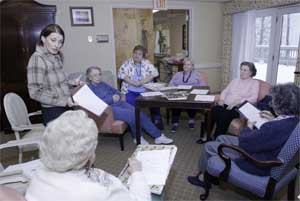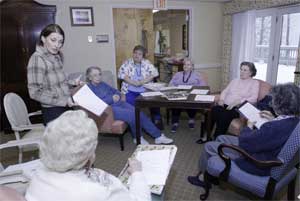 Fashion and Textiles researcher seeks direct input from older women
Fashion and Textiles researcher seeks direct input from older women
KINGSTON, R.I. – February 28, 2008 – Claire Lacoste Kapstein arrived at the University of Rhode Island in the Fall of 2006 after a successful career designing knitwear for women and children, operating a global wholesale children’s clothing business, and managing a specialty store in Cambridge, Mass. Along the way she developed an interest in designing clothing that addresses the unique needs of a group she dubbed “Wellderly women” – older women who are still active and healthy.
“I’ve always been comfortable talking with older people, I’m a woman, and I’ll grow old, so it seemed only natural to want to design for this population. They have become my passion,“ said Kapstein, a URI assistant professor in the Department of Textiles, Fashion Merchandising & Design “And as the Baby Boomers get older, the apparel market for them will be booming.”
So Kapstein went back to school and earned graduate degrees in textiles, clothing design, and gerontology to better understand their needs. And now she is beginning to meet with groups of older women at retirement communities and elsewhere to seek their input.
“Women in their 60s and 70s, many of whom are still working, want fashionable apparel just like everyone else, though they are also more concerned about comfort, especially in pants,” Kapstein explained. “I’m focusing more on the product development outlook for women 80 and older who need apparel adapted to all aspects of aging including identity, mobility, security, and age-related physical changes and yet who still want fashionable items.”
Kapstein noted that older women consider the functionality and practicality of clothing as well as its comfort and security. For instance, she said that robes or dresses that are too long make it difficult for mature women to climb stairs, and large sleeves that could get caught on something or get burned at the stove are also a concern. Older women also want high quality fabrics made of natural and synthetic fibers, and they seek adapted blends that will reduce static and are kind to their skin.
When she visits retirement homes to seek input from the residents, “they love to talk and they provide invaluable qualitative material on the present reality of their needs and desires,” said Kapstein, who hopes to consult for manufacturers looking to reach this market. “I ask them about their grooming and dressing habits as well as their apparel consumptions and they all respond to me and open up.”
By examining recurrent themes expressed by the women, she hopes to learn more about the psycho-sociological aspects of what dress means in their older years. “Is price a major consideration when choosing clothes? How and where do they prefer to buy apparel? What do beauty and attractiveness mean in older years? How do health issues impact their self-image?” said Kapstein. “There is clearly a changing perception of what aging means.”
With the apparel market for the aging population expected to continue growing for the next 40 years and with a projection of over 320 million people over age 65 in China alone, Kapstein and her students have a great opportunity to make an impact on a market ignored by most designers.
She admits, however, to the challenges of inspiring her young students to take an interest in designing for the mature market.
“I taught a seminar class last spring on ‘Fashion for All Ages,’ which was a good start to getting them to think beyond the young market,” Kapstein said. “Eventually I’ll have a senior level course on apparel for the mature woman. That will convince them that this is a market that deserves their attention.”
Pictured above
URI Textiles Professor Claire Kapstein (standing) talks with residents of North Bay Manor in Smithfield about fashion and their clothing preferences. Kapstein designs apparel for mature women. URI Department of Communications & Marketing photo by Michael Salerno Photography.

